Geologically Meaningful 40Ar/39Ar Ages of Altered Biotite from a Polyphase Deformed Shear Zone Obtained by in Vacuo Step-Heating Method: A Case Study of the Waziyü Detachment Fault, Northeast China
Abstract
:1. Introduction
2. Geological Setting
3. Sample Collection and Analytical Techniques
3.1. Sample Collection
3.2. 40Ar/39Ar Dating
4. Results
4.1. K-Feldspar Age
4.2. Step-Heating Biotite Data
4.3. Total Fusion Biotite Ages
4.4. In Situ Laser Ablation Ages
5. Discussion
5.1. The Effect of Epidotization on Biotite Argon Systematics
5.2. Implications for Interpretation of Total Fusion and In Situ Laser Ablation Ages and Disturbed Biotite 40Ar/39Ar Age Spectra
5.3. Implications for the Deformation History of the Waziyü Detachment Fault
6. Conclusions
Supplementary Materials
Author Contributions
Funding
Acknowledgments
Conflicts of Interest
References
- Hodges, K.V.; Harries, W.E.; Bowring, S.A. 40Ar/39Ar age gradients in micas from a high-temperature-low-pressure metamorphic terrain: Evidence for very slow cooling and implications for the interpretation of age spectra. Geology 1994, 22, 55. [Google Scholar] [CrossRef]
- Berger, G.W. 40Ar/39Ar step heating of thermally overprinted biotite, hornblende and potassium feldspar from Eldora, Colorado. Earth Planet. Sci. Lett. 1975, 26, 387–408. [Google Scholar] [CrossRef]
- Hanson, G.N.; Simmons, K.R.; Bence, A. 40Ar/39Ar spectrum ages for biotite, hornblende and muscovite in a contact metamorphic zone. Geochim. Cosmochim. Acta 1975, 39, 1269–1278. [Google Scholar] [CrossRef]
- York, D.; Martinez, M.L. the two-faced mica. Geophys. Res. Lett. 1986, 13, 973–975. [Google Scholar] [CrossRef]
- Onstott, T.; Peacock, M. Argon retentivity of hornblendes: A field experiment in a slowly cooled metamorphic terrane. Geochim. Cosmochim. Acta 1987, 51, 2891–2903. [Google Scholar] [CrossRef]
- Wintsch, R.P.; Kunk, M.; Mulvey, B.K.; Southworth, C.S. 40Ar/39Ar dating of Silurian and Late Devonian cleavages in lower greenschist-facies rocks in the Westminster terrane, Maryland, USA. GSA Bull. 2009, 122, 658–677. [Google Scholar] [CrossRef]
- Ching-Hua, L.; Onstott, T. 39Ar recoil artifacts in chloritized biotite. Geochim. Cosmochim. Acta 1989, 53, 2697–2711. [Google Scholar] [CrossRef]
- Lo, C.H.; Lee, J.K.; Onstott, T.C. Argon release mechanisms of biotite in vacuo and the role of short-circuit diffusion and recoil. Chem. Geol. 2000, 165, 135–166. [Google Scholar] [CrossRef]
- Roberts, H.; Kelley, S.P.; Dahl, P. Obtaining geologically meaningful 40Ar–39Ar ages from altered biotite. Chem. Geol. 2001, 172, 277–290. [Google Scholar] [CrossRef]
- Di Vincenzo, G.; Viti, C.; Rocchi, S. The effect of chlorite interlayering on 40Ar/39Ar biotite dating: An 40Ar/39Ar laser-probe and TEM investigations of variably chloritised biotites. Contrib. Min. Pet. 2003, 145, 643–658. [Google Scholar] [CrossRef]
- Kula, J.; Spell, T.L.; Zanetti, K.A. 40Ar/39Ar analyses of artificially mixed micas and the treatment of complex age spectra from samples with multiple mica populations. Chem. Geol. 2010, 275, 67–77. [Google Scholar] [CrossRef]
- Skipton, D.; Warren, C.; Hanke, F. Numerical models of P–T, time and grain-size controls on Ar diffusion in biotite: An aide to interpreting 40Ar/39Ar ages. Chem. Geol. 2018, 496, 14–24. [Google Scholar] [CrossRef]
- Kelley, S.P. Rapid Kimberlite Ascent and the Significance of Ar-Ar Ages in Xenolith Phlogopites. Science 2000, 289, 609–611. [Google Scholar] [CrossRef] [PubMed] [Green Version]
- Cosca, M.A.; Stünitz, H.; Bourgeix, A.-L.; Lee, J.P. 40Ar* loss in experimentally deformed muscovite and biotite with implications for 40Ar/39Ar geochronology of naturally deformed rocks. Geochim. Cosmochim. Acta 2011, 75, 7759–7778. [Google Scholar] [CrossRef]
- Beltrando, M.; Di Vincenzo, G.; Ferraris, C. Preservation of sub-microscopic structural relicts in micas from the Gran Paradiso Massif (Western Alps): Implications for 40Ar–39Ar geochronology. Geochim. Cosmochim. Acta 2013, 119, 359–380. [Google Scholar] [CrossRef]
- Di Vincenzo, G.; Grande, A.; Prosser, G.; Cavazza, W.; DeCelles, P.G. 40Ar–39Ar laser dating of ductile shear zones from central Corsica (France): Evidence of Alpine (middle to late Eocene) syn-burial shearing in Variscan granitoids. Lithos 2016, 262, 369–383. [Google Scholar] [CrossRef]
- Schwartz, G.M. Aleration of biotite under mesothermal conditions. Econ. Geol. 1958, 53, 164–177. [Google Scholar] [CrossRef]
- Darby, B.J.; Davis, G.A.; Zhang, X.H.; Wu, F.Y.; Wilde, S.; Yang, J.H. The newly discovered Waziyu metamorphic core complex, Yiwulü Shan, western Liaoning Province, Northwest China. Earth Sci. Front. 2004, 11, 145–155. [Google Scholar]
- Ma, Y.S.; Cui, S.Q.; Wu, G.G.; Wu, Z.H.; Zhu, D.G.; Li, X.; Feng, X.Y. Uplift history of the Yiwulüshan Mountains in West Liaoning (in Chinese with English abstract). Acta Geosci. Sin. 2000, 21, 245–253. [Google Scholar]
- Lin, W.; Faure, M.; Chen, Y.; Ji, W.; Wang, F.; Wu, L.; Charles, N.; Wang, J.; Wang, Q. Late Mesozoic compressional to extensional tectonics in the Yiwulüshan massif, NE China and its bearing on the evolution of the Yinshan–Yanshan orogenic belt Part I: Structural analyses and geochronological constraints. Gondwana Res. 2013, 23, 54–77. [Google Scholar] [CrossRef] [Green Version]
- Wang, T.; Guo, L.; Zheng, Y.; Donskaya, T.V.; Gladkochub, D.; Zeng, L.; Li, J.; Wang, Y.; Mazukabzov, A. Timing and processes of late Mesozoic mid-lower-crustal extension in continental NE Asia and implications for the tectonic setting of the destruction of the North China Craton: Mainly constrained by zircon U–Pb ages from metamorphic core complexes. Lithos 2012, 154, 315–345. [Google Scholar] [CrossRef]
- Wu, F.Y.; Walker, R.J.; Yang, Y.H.; Yuan, H.L.; Yang, J.H. The chemical-temporal evolution of lithospheric mantle underlying the North China Craton. Geochim. Cosmochim. Acta 2006, 70, 5013–5034. [Google Scholar] [CrossRef]
- Zhang, X.H.; Mao, Q.; Zhang, H.F.; Wilde, S.A. A Jurassic peraluminous leucogranite from Yiwulüshan, western Liaoning, North China craton: Age, origin and tectonic significance. Geol. Mag. 2008, 145, 305–320. [Google Scholar] [CrossRef]
- Zhang, X.H.; Li, T.S.; Pu, Z.P. 40Ar/39Ar thermochronology of two ductile shear zones from Yiwulü Shan, west Liaoning region: Age constraints on Mesozoic tectonic events. Chin. Sci. Bull. 2002, 47, 1113–1118. [Google Scholar]
- Zhai, M.G.; Meng, Q.R.; Liu, J.M.; Hou, Q.L.; Hu, S.B.; Li, Z.; Zhang, H.F.; Liu, W.; Shao, J.A.; Zhu, R.X. Geological features of Mesozoic tectonic regime inversion in Eastern North China and implication for geodynamics (in Chinese with English abstract). Earth Sci. Front. 2004, 11, 285–297. [Google Scholar]
- Li, G.; Xu, Z.Y.; Liu, Z.H.; Li, Y.F.; Li, S.C.; Dong, X.J. Early Cretaceous extension of the Yiwulüshan metamorphic core complex (in Chinese with English abstract). Acta Petrol. Sin. 2013, 29, 938–950. [Google Scholar]
- Wang, F.; Jourdan, F.; Lo, C.H.; Nomade, S.; Guillou, H.; Zhu, R.; Yang, L.; Shi, W.; Feng, H.; Wu, L.; et al. YBCs sanidine: A new standard for 40Ar/39Ar dating. Chem. Geol. 2014, 388, 87–97. [Google Scholar] [CrossRef]
- Steiger, R.H.; Jäger, E. Subcommision on Geochronology: Convention on the use of decay constants in geo- and cosmochronology. Earth Planet. Sci. Lett. 1977, 36, 359–362. [Google Scholar] [CrossRef]
- Koppers, A.A.P. ArArCALC—software for 40Ar/39Ar age calculations. Comput. Geosci. 2002, 28, 605–619. [Google Scholar] [CrossRef]
- Renne, P.R.; Deino, A.L.; Hames, W.E.; Heizler, M.T.; Hemming, S.R.; Hodges, K.V.; Koppers, A.A.P.; Mark, D.F.; Morgan, L.E.; Phillips, D.; et al. Data reporting norms for 40Ar/39Ar geochronology. Quat. Geochronol. 2009, 4, 346–352. [Google Scholar] [CrossRef]
- Gatta, G.D.; Merlini, M.; Lee, Y.; Poli, S. Behavior of epidote at high pressure and high temperature: A powder diffraction study up to 10 GPa and 1200 K. Phys. Chem. Min. 2011, 38, 419–428. [Google Scholar] [CrossRef]
- Eggleton, R.A.; Banfield, J.F. The alteration of granitic biotite to chlorite. Am. Mineral. 1985, 70, 902–910. [Google Scholar]
- Harrison, T.; Duncan, I.; McDougall, I. Diffusion of 40Ar in biotite: Temperature, pressure and compositional effects. Geochim. Cosmochim. Acta 1985, 49, 2461–2468. [Google Scholar] [CrossRef]
- Lee, J.K.W. Multipath diffusion in geochronology. Contrib. Mineral. Petrol. 1995, 120, 60–82. [Google Scholar] [CrossRef]
- Onstott, T.; Hall, C.; York, D. 40Ar/39Ar thermochronometry of the Imataca Complex, Venezuela. Precambrian Res. 1989, 42, 255–291. [Google Scholar] [CrossRef]
- Grove, M.; Harrison, T.M. 40Ar* diffusion in Fe-rich biotite. Am. Mineral. 1996, 81, 940–951. [Google Scholar] [CrossRef]
- Giletti, B.I. Studies in diffusion: I. Argon in phlogopite mica. In Geochemical Transport and Kinetics; Hofmann, A.W., Giletti, B.J., Yoder, H.S., Yund, R.A., Eds.; Carnegie Institute of Washington: Washington, DC, USA, 1974; publication 634; pp. 107–115. [Google Scholar]
- Cassata, W.S.; Renne, P.R.; Shuster, D. Argon diffusion in plagioclase and implications for thermochronometry: A case study from the Bushveld Complex, South Africa. Geochim. Cosmochim. Acta 2009, 73, 6600–6612. [Google Scholar] [CrossRef]
- Parry, W.T. Geochemistry of Hydrothermal Chlorite Replacing Igneous Biotite. Clays Clay Min. 1982, 30, 81–90. [Google Scholar] [CrossRef]
- De Caritat, P. Chlorite Geothermometry: A Review. Clays Clay Min. 1993, 41, 219–239. [Google Scholar] [CrossRef]
- Foland, K. 40Ar/39Ar incremental heating plateaus for biotites with excess argon. Chem. Geol. (Isot. Geosci. Sect.) 1983, 41, 3–21. [Google Scholar] [CrossRef]
- Viti, C.; Di Vincenzo, G.; Mellini, M. Thermal transformations in laser-heated chloritized annite. Phys. Chem. Min. 2004, 31, 92–101. [Google Scholar] [CrossRef]
- McDougall, I.; Harrison, T.M. Geochronology and Thermochronology by the 40Ar/39Ar Method; Oxford University Press: Oxford, UK, 1999; pp. 148–153. [Google Scholar]
- Harrison, T.M.; Heizler, M.T.; Lovera, O.M.; Wenji, C.; Grove, M. A chlorine disinfectant for excess argon released from K-felsspar during step heating. Earth Planet. Sci. Lett. 1994, 123, 95–104. [Google Scholar] [CrossRef]
- He, H.; Deng, C.; Pan, Y.; Deng, T.; Luo, Z.; Sun, J.; Zhu, R. New 40Ar/39Ar dating results from the Shanwang Basin, eastern China: Constraints on the age of the Shanwang Formation and associated biota. Phys. Earth Planet. Inter. 2011, 187, 66–75. [Google Scholar] [CrossRef]
- Jin, L.Y. Xenoliths in Cenozoic basalts from Tanlu fault. J. Changchun Coll. Geol. 1985, 3, 21–32. (In Chinese) [Google Scholar]
- Zheng, J.P.; Lu, F.X.; Griffin, W.L.; Yu, C.M.; Zhang, R.S.; Yuan, X.P.; Wu, X.L. Lithospheric thinning accompanying mantle lateral spreading, erosion and replacement beneath the eastern part of North China: Evidence from peridotites (in Chinese with English abstract). Earth Sci. Front. 2006, 13, 76–85. [Google Scholar]
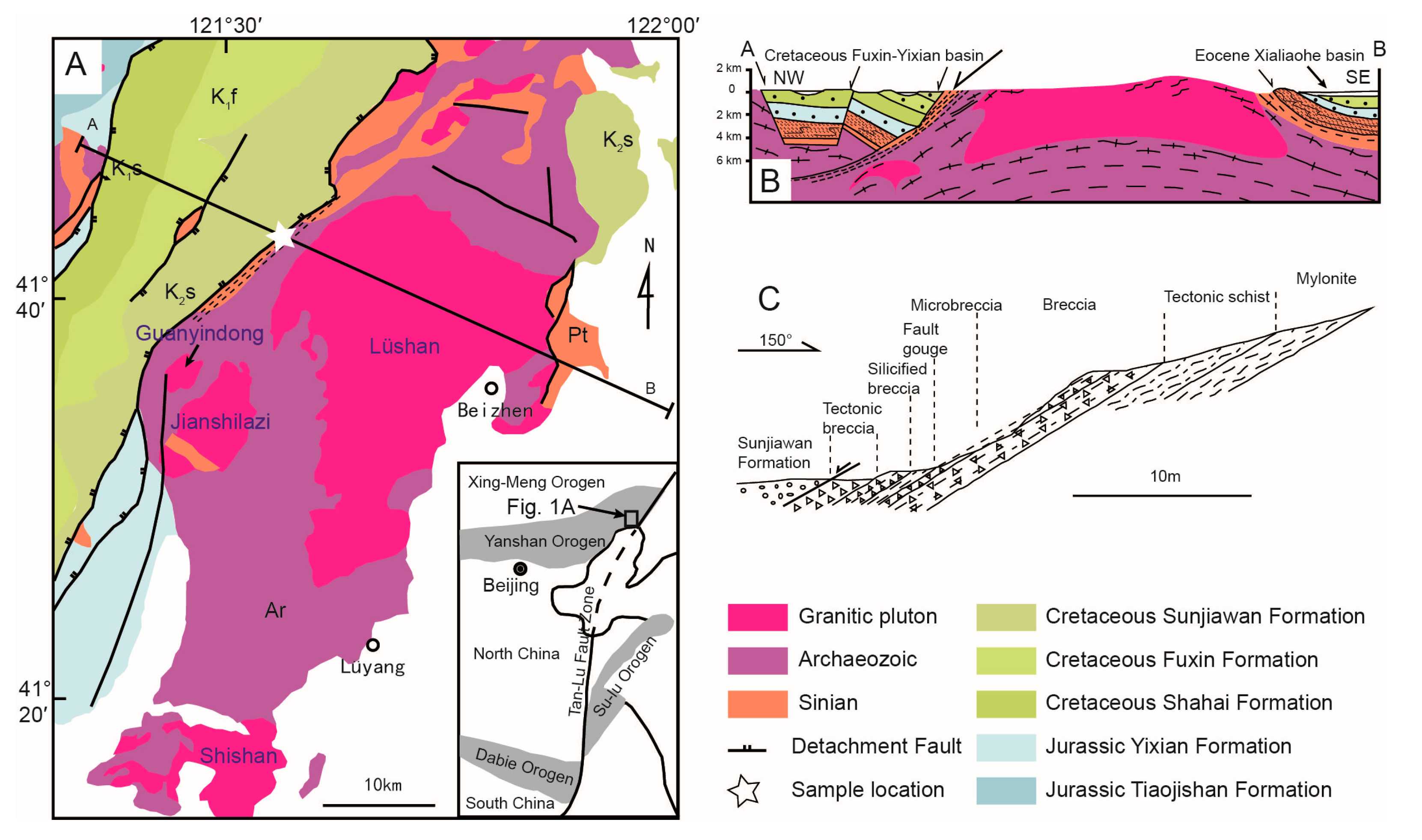
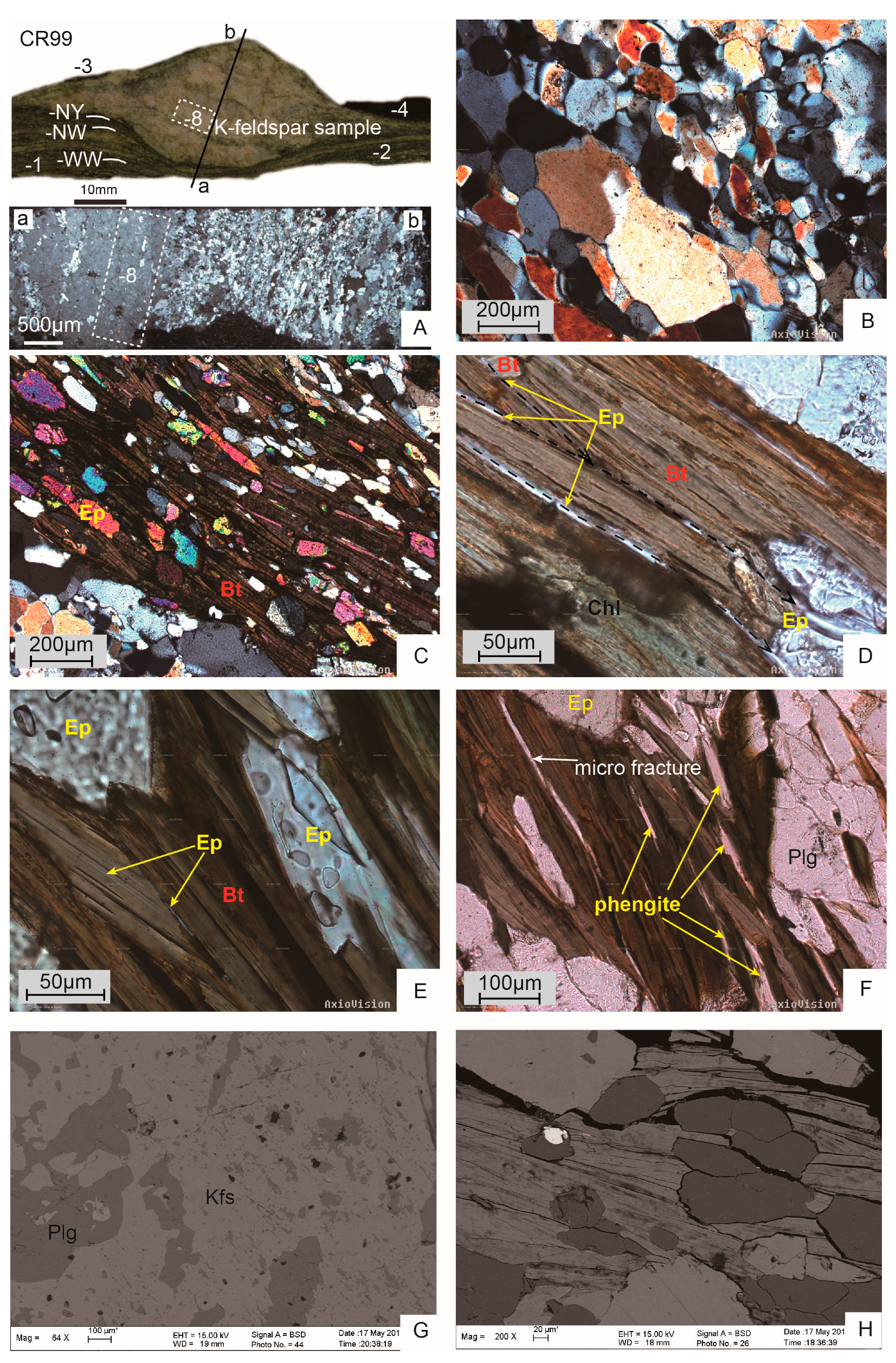
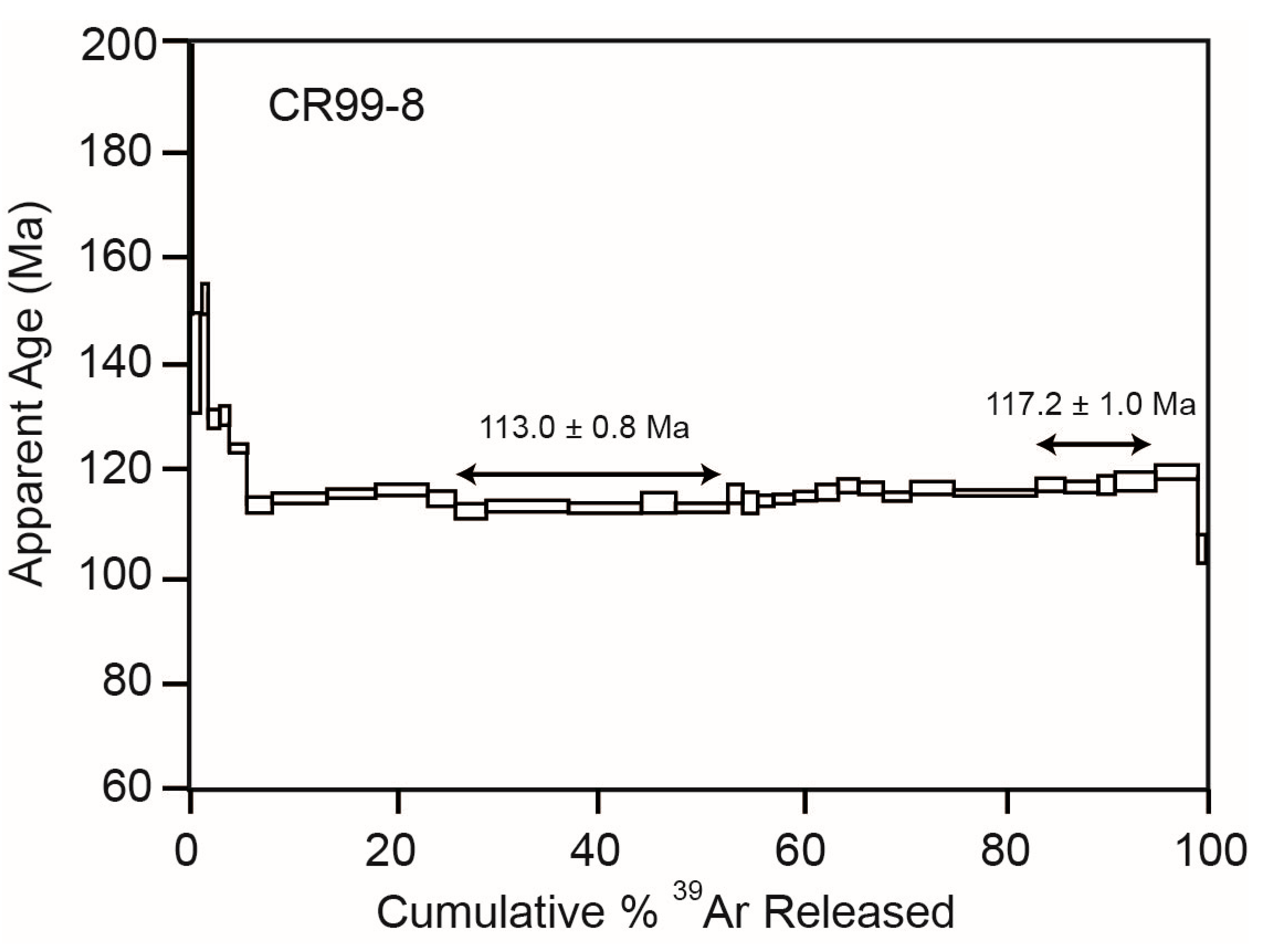
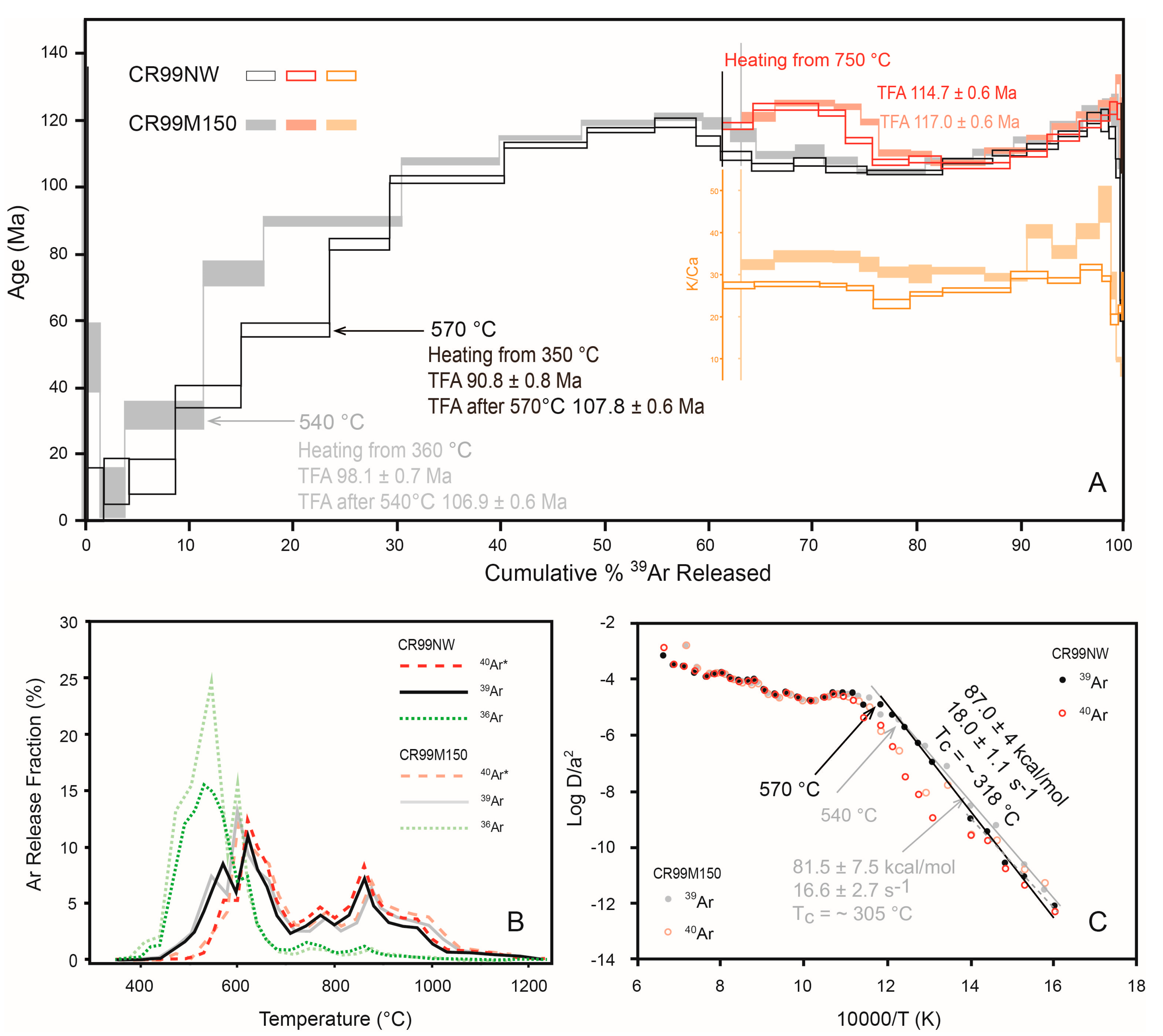
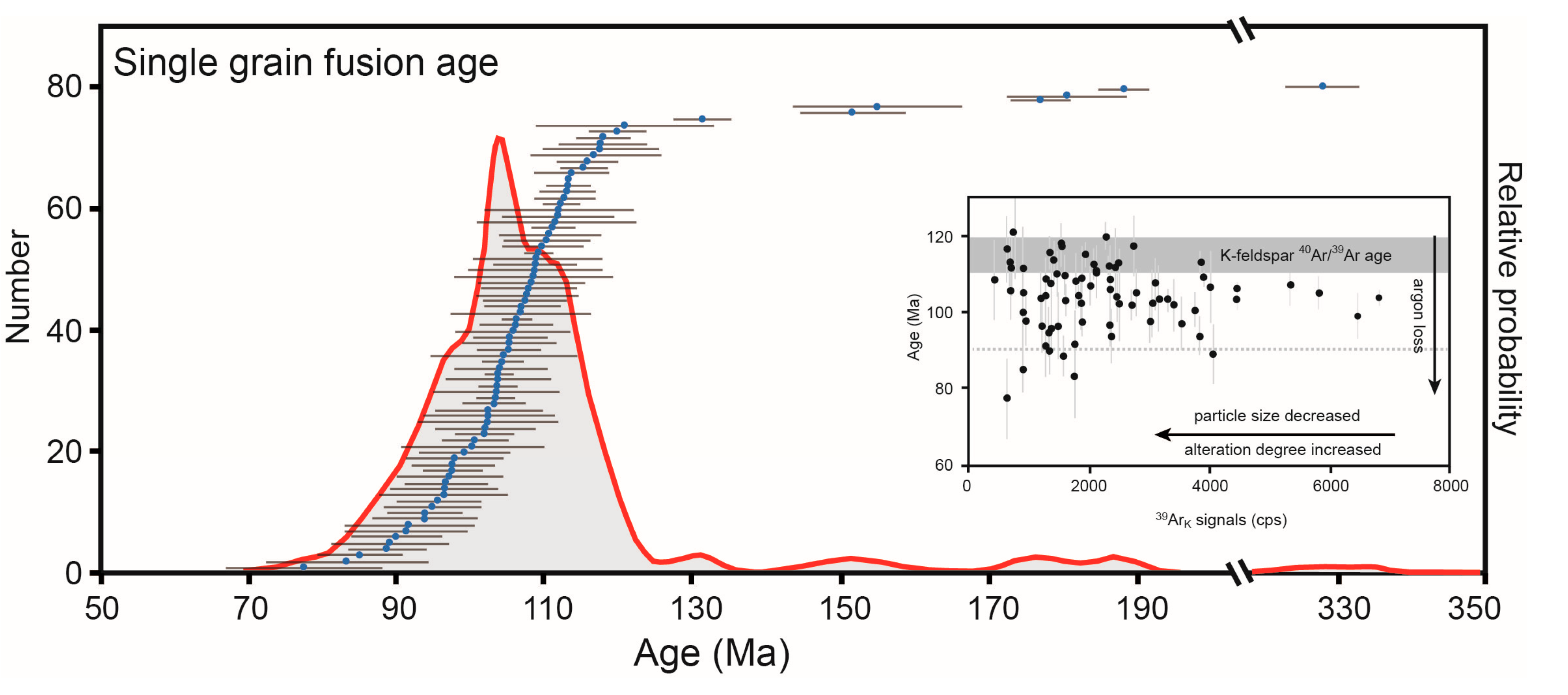
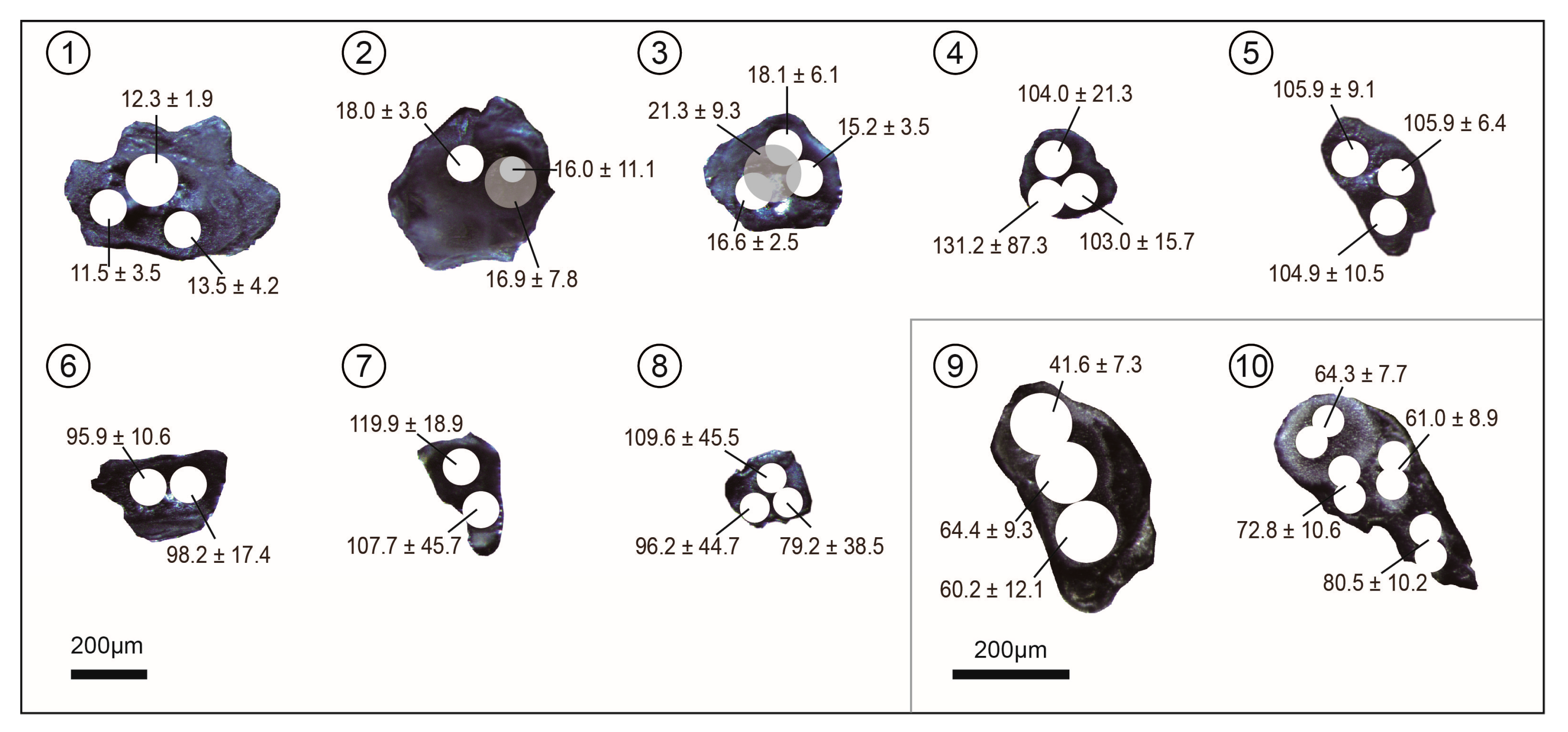
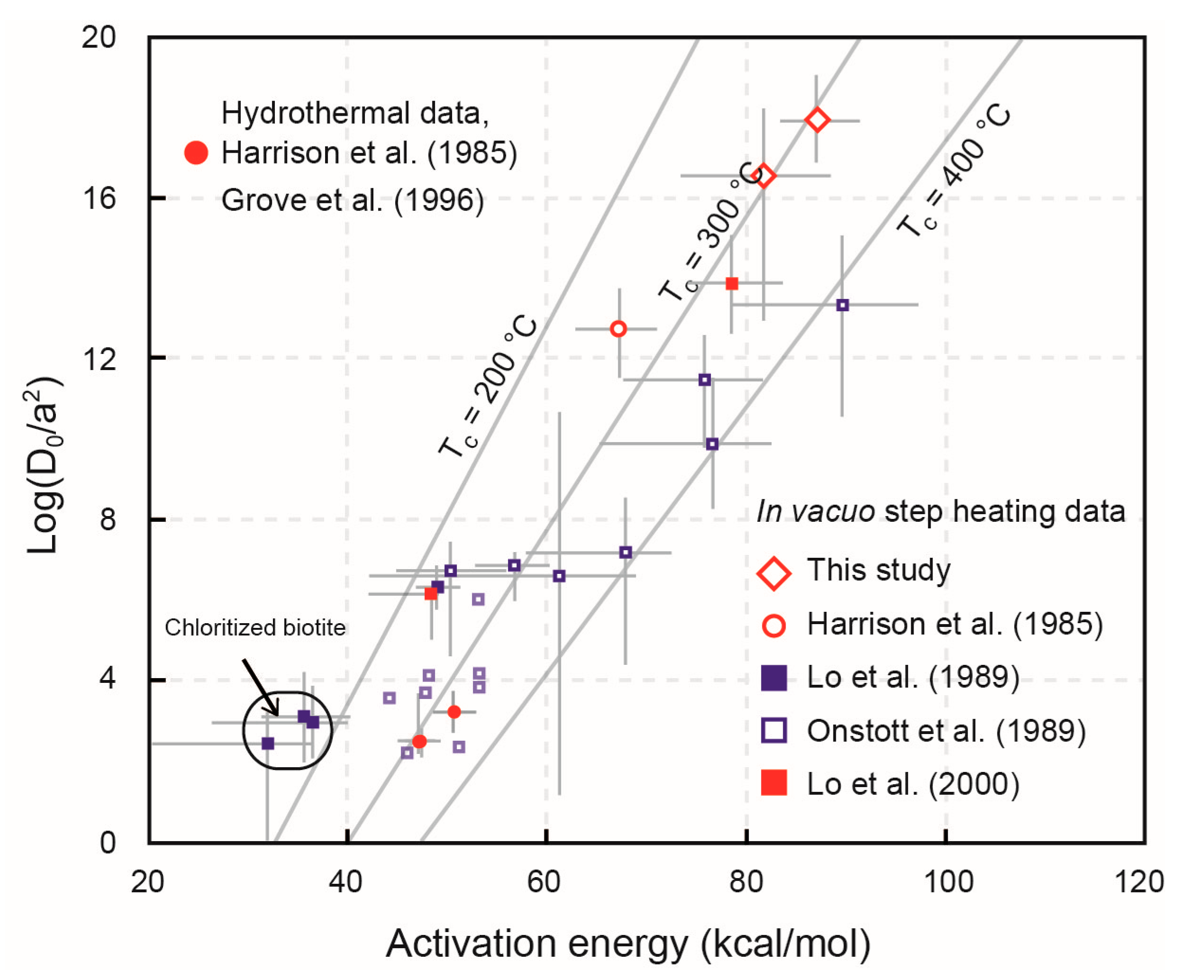
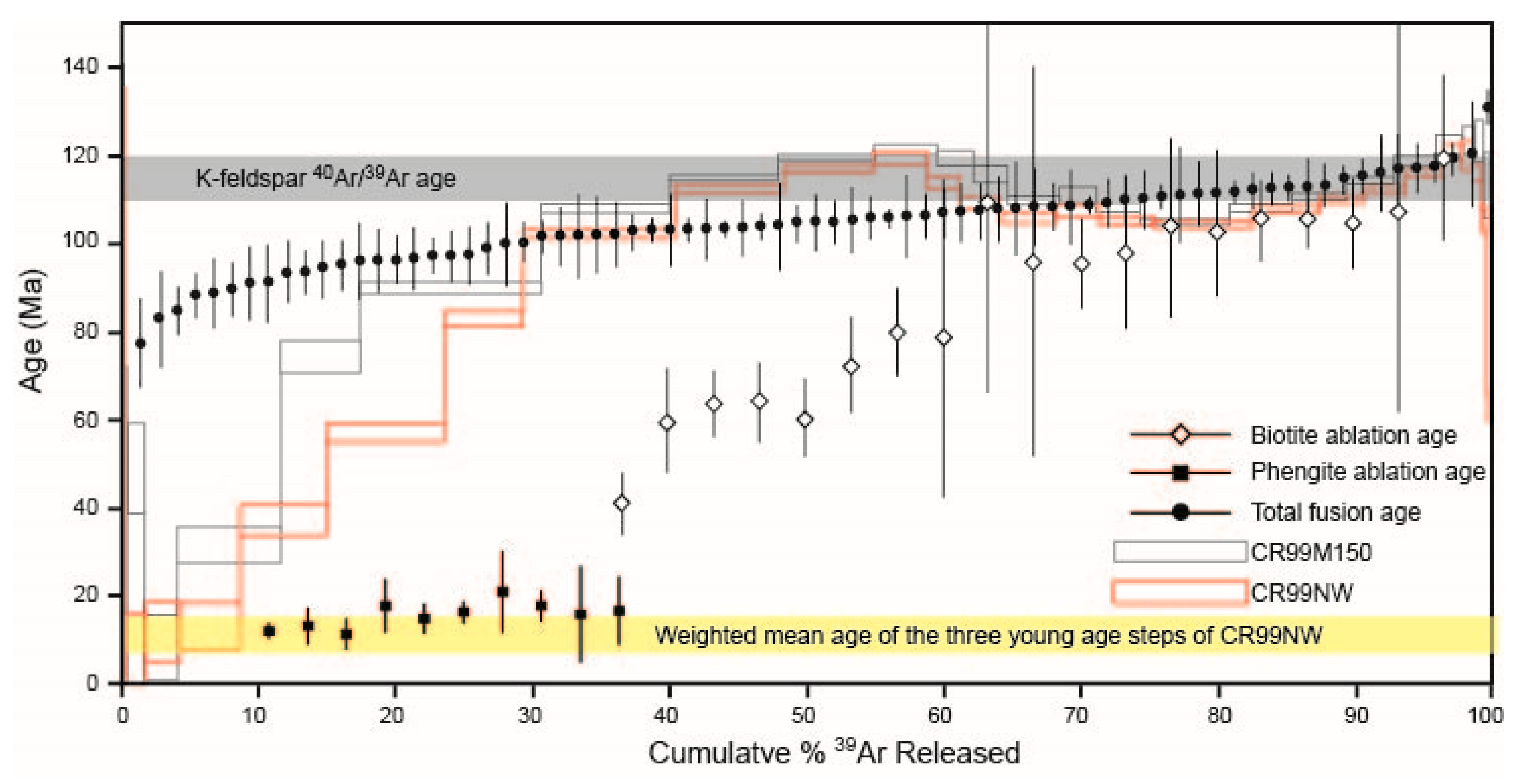
| Mineral | Na2O | F | BaO | Cl | MgO | SiO2 | TiO2 | FeO | Al2O3 | Cr2O3 | K2O | MnO | CaO | Total |
|---|---|---|---|---|---|---|---|---|---|---|---|---|---|---|
| Epidote | 0.03 | n/a | n/a | 0.01 | n/a | 38.64 | 0.08 | 10.98 | 23.47 | 0.07 | 0.01 | 0.07 | 22.66 | 96.00 |
| n/a | n/a | 0.03 | 0.01 | 0.06 | 38.53 | 0.09 | 11.77 | 23.04 | 0.03 | n/a | 0.10 | 22.61 | 96.26 | |
| n/a | n/a | n/a | n/a | 0.01 | 38.16 | 0.12 | 11.11 | 23.39 | 0.05 | n/a | 0.16 | 22.78 | 95.79 | |
| Phengitic white mica | 0.41 | n/a | 0.63 | 0.27 | 2.82 | 48.24 | 0.50 | 4.57 | 24.48 | 0.39 | 10.12 | 0.03 | 0.07 | 92.46 |
| 0.13 | n/a | 0.48 | n/a | 3.21 | 49.24 | 0.53 | 4.74 | 25.00 | 0.04 | 9.90 | 0.05 | 0.03 | 93.35 | |
| 0.26 | n/a | 0.34 | n/a | 2.99 | 49.05 | 0.04 | 3.27 | 25.67 | 0.68 | 10.25 | 0.01 | 0.08 | 92.64 | |
| Biotite | 0.07 | n/a | 0.06 | n/a | 12.67 | 38.26 | 1.70 | 16.78 | 15.79 | 0.09 | 9.69 | 0.27 | 0.05 | 95.41 |
| 0.06 | n/a | 0.08 | n/a | 12.50 | 38.55 | 1.58 | 15.45 | 16.10 | n/a | 9.27 | 0.26 | 0.09 | 93.92 | |
| Chloritized biotite | 0.14 | n/a | 0.05 | 0.01 | 11.17 | 35.59 | 1.59 | 14.68 | 14.18 | 0.30 | 7.35 | 0.20 | 1.74 | 86.99 |
| 0.18 | n/a | 0.04 | 0.01 | 12.88 | 32.70 | 0.53 | 14.82 | 16.24 | 0.43 | 2.42 | 0.25 | 2.00 | 82.49 | |
| K-feldspar | 0.93 | 0.01 | 1.40 | 0.02 | 0.03 | 64.13 | 0.05 | 0.10 | 18.56 | n/a | 14.57 | n/a | 0.01 | 99.79 |
| 0.92 | 0.09 | 1.30 | n/a | n/a | 64.59 | 0.05 | n/a | 18.51 | 0.04 | 14.57 | 0.05 | n/a | 100.09 |
| Sample | Size | Tem. | Age (Ma) | (40Ar/36Ar)i | ||||||
|---|---|---|---|---|---|---|---|---|---|---|
| (µm) | (°C) | Initial | Flat I | Dip | Flat II | T.F. | Plateau | Isochron | ||
| CR99-1 | 180–250 | 112.3 ± 2.1 | 129.5 ± 1.2 | 108.8 ± 2.0 | 137.9 ± 1.9 | 121.6 ± 0.7 | 119.0 ± 1.9 | 119.2 ± 17.3 | 294.8 ± 80.3 | |
| CR99-2 | 650D | 107.6 ± 2.3 | 129.0 ± 1.2 | 95.2 ± 3.5 | 145.5 ± 1.3 | 118.7 ± 0.8 | n/a | n/a | ||
| CR99-3 | 700S | 124.0 ± 1.0 | 140.3 ± 0.7 | 121.1 ± 1.0 | 138.9 ± 1.5 | 131.7 ± 0.7 | n/a | n/a | ||
| CR99-4 | 115.9 ± 2.2 | 130.8 ± 1.3 | 121.0 ± 1.4a | 132.5 ± 2.8a | 124.2 ± 0.7 | 121.0 ± 1.4 | 122.2 ± 4.6 | 288.1 ±26.4 | ||
| CR99WW | 150–180 | 102.7 ± 2.3 | 89.0 ± 2.3 | 112.8 ± 2.7a | 95.4 ± 1.0 | 92.5 ± 2.1 | 98.0 ± 15.1 | 272.1 ± 64.2 | ||
| CR99NW | 700D | 116.8 ± 1.1 | 122.5 ± 1.0 | 105.6 ± 1.1a | 122.3 ± 1.9 | 112.9 ± 0.6 | n/a | n/a | ||
| CR99NY | 750S | 123.6 ± 1.5 | 127.9 ± 1.2 | 105.8 ± 1.0 | 126.5 ± 1.3a | 117.6 ± 0.7 | n/a | n/a | ||
| CR99M | 120–150 | 118.3 ± 1.4a | 105.6 ± 0.9a | 122.1 ± 1.4 | 109.0 ± 0.8 | 105.6 ± 0.9 | 109.1 ± 8.9 | 267.1 ± 71.7 | ||
| CR99M150 | 100–120 | 118.8 ± 1.4 | 123.4 ± 0.7 | 105.5 ± 0.7 | 130.9 ± 1.3 | 115.3 ± 0.6 | n/a | n/a | ||
| CR99NW | 350S | 4.6 ± 13.1 | 119.4 ± 1.3 | 104.4 ± 0.7 | 120.8 ± 1.6 | 90.8 ± 0.8 | n/a | n/a | ||
| CR99M150 | 360S | 7.8 ± 7.4 | 121.0 ± 1.0 | 104.5 ± 0.6 | 123.2 ± 3.3 | 98.1 ± 0.7 | n/a | n/a | ||
| CR99-8 | 180–250 | 450S | 113.0 ± 0.8 | 117.2 ± 1.0 | 117.3 ± 0.7 | |||||
© 2020 by the authors. Licensee MDPI, Basel, Switzerland. This article is an open access article distributed under the terms and conditions of the Creative Commons Attribution (CC BY) license (http://creativecommons.org/licenses/by/4.0/).
Share and Cite
Shi, W.; Wang, F.; Wu, L.; Yang, L.; Wang, Y.; Shi, G. Geologically Meaningful 40Ar/39Ar Ages of Altered Biotite from a Polyphase Deformed Shear Zone Obtained by in Vacuo Step-Heating Method: A Case Study of the Waziyü Detachment Fault, Northeast China. Minerals 2020, 10, 648. https://doi.org/10.3390/min10080648
Shi W, Wang F, Wu L, Yang L, Wang Y, Shi G. Geologically Meaningful 40Ar/39Ar Ages of Altered Biotite from a Polyphase Deformed Shear Zone Obtained by in Vacuo Step-Heating Method: A Case Study of the Waziyü Detachment Fault, Northeast China. Minerals. 2020; 10(8):648. https://doi.org/10.3390/min10080648
Chicago/Turabian StyleShi, Wenbei, Fei Wang, Lin Wu, Liekun Yang, Yinzhi Wang, and Guanghai Shi. 2020. "Geologically Meaningful 40Ar/39Ar Ages of Altered Biotite from a Polyphase Deformed Shear Zone Obtained by in Vacuo Step-Heating Method: A Case Study of the Waziyü Detachment Fault, Northeast China" Minerals 10, no. 8: 648. https://doi.org/10.3390/min10080648
APA StyleShi, W., Wang, F., Wu, L., Yang, L., Wang, Y., & Shi, G. (2020). Geologically Meaningful 40Ar/39Ar Ages of Altered Biotite from a Polyphase Deformed Shear Zone Obtained by in Vacuo Step-Heating Method: A Case Study of the Waziyü Detachment Fault, Northeast China. Minerals, 10(8), 648. https://doi.org/10.3390/min10080648







